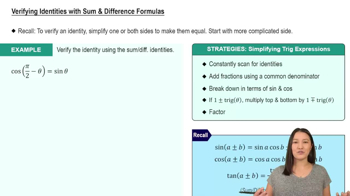Verify that each equation is an identity.
(tan(α + β) - tan β)/(1 + tan(α + β) tan β) = tan α
 Verified step by step guidance
Verified step by step guidance Verified video answer for a similar problem:
Verified video answer for a similar problem:



 6:14m
6:14mMaster Sum and Difference of Sine & Cosine with a bite sized video explanation from Patrick
Start learning